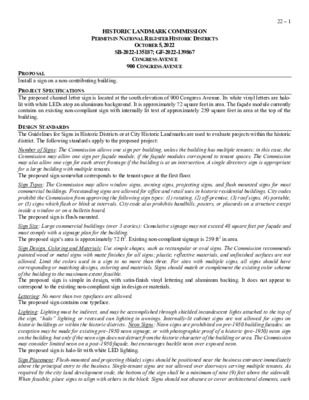22.0 - 900 Congress Ave — original pdf
Backup

HISTORIC LANDMARK COMMISSION PERMITS IN NATIONAL REGISTER HISTORIC DISTRICTS OCTOBER 5, 2022 SB-2022-135187; GF-2022-139867 CONGRESS AVENUE 900 CONGRESS AVENUE 22 – 1 PROPOSAL Install a sign on a non-contributing building. PROJECT SPECIFICATIONS The proposed channel letter sign is located at the south elevation of 900 Congress Avenue. Its white vinyl letters are halo- lit with white LEDs atop an aluminum background. It is approximately 72 square feet in area. The façade module currently contains an existing non-compliant sign with internally lit text of approximately 259 square feet in area at the top of the building. DESIGN STANDARDS The Guidelines for Signs in Historic Districts or at City Historic Landmarks are used to evaluate projects within the historic district. The following standards apply to the proposed project: Number of Signs: The Commission allows one sign per building, unless the building has multiple tenants; in this case, the Commission may allow one sign per façade module, if the façade modules correspond to tenant spaces. The Commission may also allow one sign for each street frontage if the building is at an intersection. A single directory sign is appropriate for a large building with multiple tenants. The proposed sign somewhat corresponds to the tenant space at the first floor. Sign Types: The Commission may allow window signs, awning signs, projecting signs, and flush mounted signs for most commercial buildings. Freestanding signs are allowed for office and retail uses in historic residential buildings. City codes prohibit the Commission from approving the following sign types: (1) rotating, (2) off-premise, (3) roof signs, (4) portable, or (5) signs which flash or blink at intervals. City code also prohibits handbills, posters, or placards on a structure except inside a window or on a bulletin board. The proposed sign is flush-mounted. Sign Size: Large commercial buildings (over 3 stories): Cumulative signage may not exceed 40 square feet per façade and must comply with a signage plan for the building. The proposed sign’s area is approximately 72 ft2. Existing non-compliant signage is 259 ft2 in area. Sign Design, Coloring and Materials: Use simple shapes, such as rectangular or oval signs. The Commission recommends painted wood or metal signs with matte finishes for all signs; plastic, reflective materials, and unfinished surfaces are not allowed. Limit the colors used in a sign to no more than three. For sites with multiple signs, all signs should have corresponding or matching designs, coloring and materials. Signs should match or complement the existing color scheme of the building to the maximum extent feasible. The proposed sign is simple in design, with satin-finish vinyl lettering and aluminum backing. It does not appear to correspond to the existing non-compliant sign in design or materials. Lettering: No more than two typefaces are allowed. The proposed sign contains one typeface. Lighting: Lighting must be indirect, and may be accomplished through shielded incandescent lights attached to the top of the sign, “halo” lighting, or recessed can lighting in awnings. Internally-lit cabinet signs are not allowed for signs on historic buildings or within the historic districts. Neon Signs: Neon signs are prohibited on pre-1950 building facades; an exception may be made for existing pre-1950 neon signage, or with photographic proof of a historic (pre-1950) neon sign on the building, but only if the neon sign does not detract from the historic character of the building or area. The Commission may consider limited neon on a post-1950 façade, but encourages backlit neon over exposed neon. The proposed sign is halo-lit with white LED lighting. Sign Placement: Flush-mounted and projecting (blade) signs should be positioned near the business entrance immediately above the principal entry to the business. Single-tenant signs are not allowed over doorways serving multiple tenants. As required by the city land development code, the bottom of the sign shall be a minimum of nine (9) feet above the sidewalk. When feasible, place signs to align with others in the block. Signs should not obscure or cover architectural elements, such as windows, decorative banding, or other ornamentation. The proposed sign is positioned at the first floor at the opposite side of the bay from the building’s entrance, as the building appears to have multiple tenants. Sign Mounting: New signs should utilize existing mounting apparatus whenever possible. If new bolt holes or brackets are necessary for sign installation, care should be taken to ensure that installation does not damage historic building materials in any way. Bolting through mortar joints avoids damage to historic stone or brick. The proposed sign will be affixed to a non-contributing building, so no historic material will be damaged. Exceptions: The City Historic Landmark Commission may consider exceptions to the foregoing provisions when warranted, and not prohibited by city ordinance. 22 – 2 Summary The project meets some of the applicable standards. STAFF RECOMMENDATION Consider the proposed new sign’s visual impact when compared with the existing non-compliant signage. Should the Commission allow the second sign, approve the application upon the condition that that the proposed sign’s size be reduced.